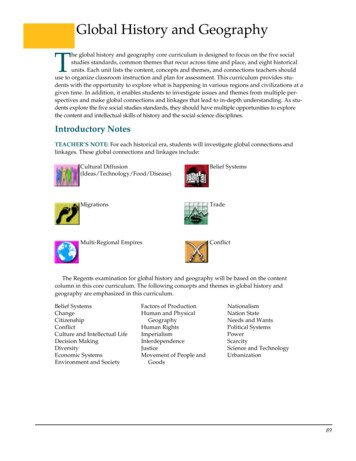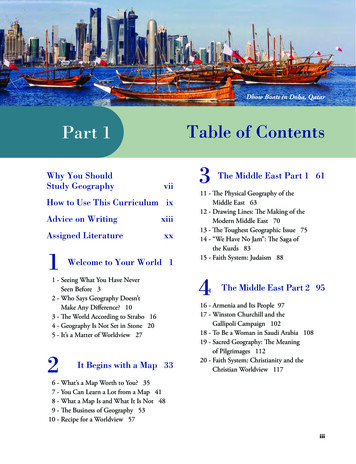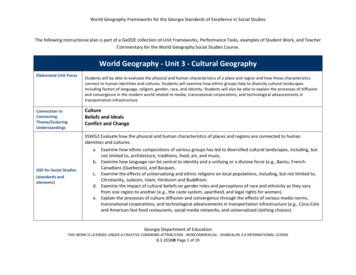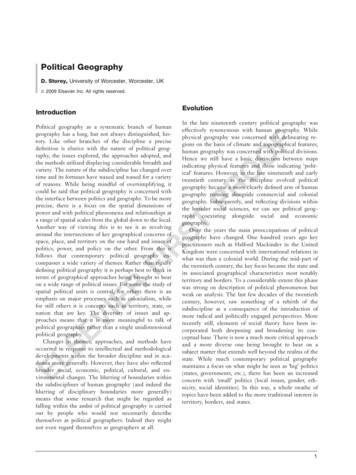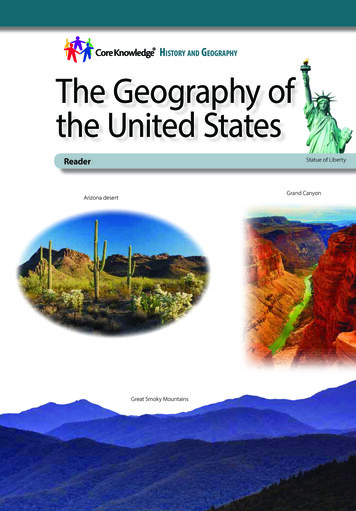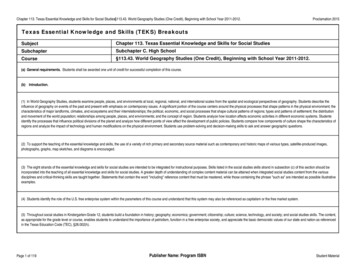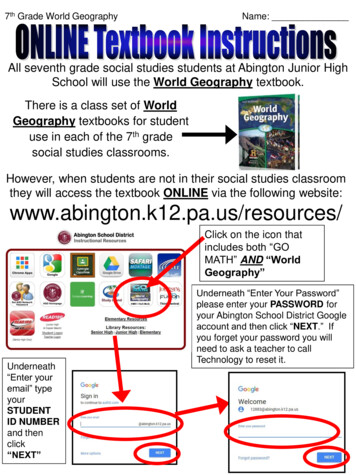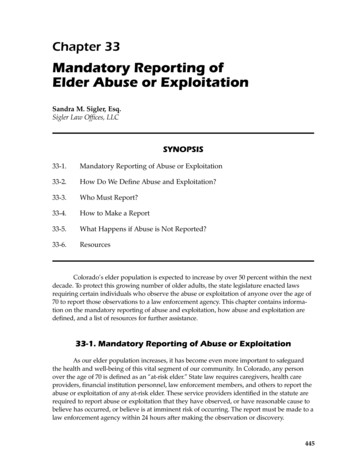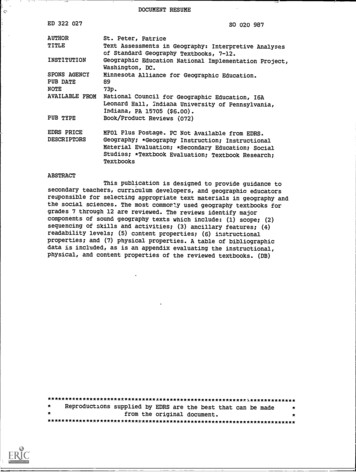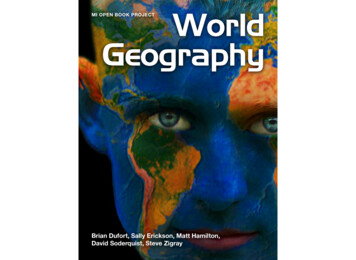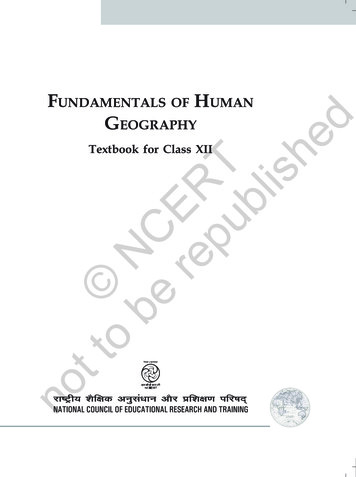
Transcription
nott o Nbe CEre Rpu TblishTextbook for Class XIIedFUNDAMENTALS OF HUMANGEOGRAPHY
ISBN 81-7450-662-4ReprintedDecember 2007 Pausa 1929December 2008 Pausa 1930January 2010 Magha 1931January 2011 Magha 1932March 2012 Phalguna 1933March 2013 Phalguna 1934January 2014 Magha 1935ALL RIGHTS RESERVED No part of this publication may be reproduced, stored in a retrieval systemor transmitted, in any form or by any means, electronic, mechanical,photocopying, recording or otherwise without the prior permission of thepublisher. This book is sold subject to the condition that it shall not, by way of trade,be lent, re-sold, hired out or otherwise disposed of without the publisher’sconsent, in any form of binding or cover other than that in which it ispublished. The correct price of this publication is the price printed on this page, Anyrevised price indicated by a rubber stamp or by a sticker or by any othermeans is incorrect and should be unacceptable.edFirst EditionFebruary 2007 Magha 1928OFFICES OF THE PUBLICATIONDIVISION, NCERTNCERT CampusSri Aurobindo MargNew Delhi 110 016Phone : 011-26562708108, 100 Feet RoadHosdakere Halli ExtensionBanashankari III StageBangaluru 560 085Phone : 080-26725740Navjivan Trust BuildingP.O.NavjivanAhmedabad 380 014Phone : 079-27541446CWC CampusOpp. Dhankal Bus StopPanihatiKolkata 700 114Phone : 033-25530454CWC ComplexMaligaonGuwahati 781 021Phone : 0361-2674869 o Nbe CEre Rpu TblishPD 35T RNB National Council of EducationalResearch and Training, 2007Publication Team 50.00Head, PublicationDivisionChief ProductionOfficerChief BusinessManagerChief Editor: Ashok Srivastava: Kalyan Banerjee: Gautam Ganguly: Naresh Yadav(Contractual Service)Editor: R. N. Bhardwaj(Contractual Service)Assistant ProductionOfficerPublished at the Publication Divisionby the Secretary, National Council ofEducational Research and Training,Sri Aurobindo Marg, New Delhi 110 016and printed Jagdamba Offset, 374,Nangli Shakrawati Industrial Area,Najafgarh, New Delhi 110 043Cover and LayoutJoel GillnottPrinted on 80 GSM paper with NCERTwatermarkIllustrationsAnil SharmaVaruni Sinha: Rajesh PippalCartographyCartographic DesignAgency
nott o Nbe CEre Rpu TblishThe National Curriculum Framework (NCF), 2005, recommends thatchildren’s life at school must be linked to their life outside the school. Thisprinciple marks a departure from the legacy of bookish learning whichcontinues to shape our system and causes a gap between the school, homeand community. The syllabi and textbooks developed on the basis of NCFsignify an attempt to implement this basic idea. They also attempt todiscourage rote learning and the maintenance of sharp boundaries betweendifferent subject areas. We hope these measures will take us significantlyfurther in the direction of a child-centred system of education outlined inthe National Policy on Education (1986).The success of this effort depends on the steps that school principalsand teachers will take to encourage children to reflect on their own learningand to pursue imaginative activities and questions. We must recognise that,given space, time and freedom, children generate new knowledge byengaging with the information passed on to them by adults. Treating theprescribed textbook as the sole basis of examination is one of the key reasonswhy other resources and sites of learning are ignored. Inculcating creativityand initiative is possible if we perceive and treat children as participantsin learning, not as receivers of a fixed body of knowledge.These aims imply considerable change in school routines and mode offunctioning. Flexibility in the daily time-table is as necessary as rigour inimplementing the annual calendar so that the required number of teachingdays are actually devoted to teaching. The methods used for teaching andevaluation will also determine how effective this textbook proves for makingchildren’s life at school a happy experience, rather than a source of stressor boredom. Syllabus designers have tried to address the problem ofcurricular burden by restructuring and reorienting knowledge at differentstages with greater consideration for child psychology and the time availablefor teaching. The textbook attempts to enhance this endeavour by givinghigher priority and space to opportunities for contemplation and wondering,discussion in small groups, and activities requiring hands-on experience.The National Council of Educational Research and Training (NCERT)appreciates the hard work done by the textbook development committeeresponsible for this book. We wish to thank the Chairperson of the advisorycommittee for textbooks in Social Sciences, at the higher secondary level,Professor Hari Vasudevan and the Chief Advisor for this book, ProfessorM.H. Qureshi for guiding the work of this committee. Several teacherscontributed to the development of this textbook; we are grateful to theirprincipals for making this possible. We are indebted to the institutions andorganisations which have generously permitted us to draw upon theirresources, material and personnel. We are especially grateful to the membersof the National Monitoring Committee, appointed by the Department ofSecondary and Higher Education, Ministry of Human Resource Developmentunder the Chairpersonship of Professor Mrinal Miri and Professor G.P.Deshpande, for their valuable time and contribution. As an organisationcommitted to systemic reform and continuous improvement in the qualityof its products, NCERT welcomes comments and suggestions which willenable us to undertake further revision and refinement.edForewordNew Delhi20 November 2006DirectorNational Council of EducationalResearch and Training
ed o Nbe CEre Rpu Tblishttno
Textbook Development CommitteeCHAIRPERSON, ADVISORY COMMITTEETHE HIGHER SECONDARY LEVELFORTEXTBOOKSINSOCIAL SCIENCESATHari Vasudevan, Professor, Department of History, University of Calcutta,KolkataM. H. Qureshi, Professor, Centre for the Study of Regional Development,Jawaharlal Nehru University, New Delhi o Nbe CEre Rpu TblishM EMBERSedC HIEF ADVISORAnindita Datta, Lecturer, Delhi School of Economics, Delhi University, DelhiAnup Saikia, Reader, Gauhati University, GuwahatiAshok Diwakar, Lecturer, Government P.G. College, Sector-9, GurgaonN. Kar, Reader, Rajiv Gandhi University, ItanagarN. Nagabhushanam, Professor, S.V. Univeristy, TirupatiN. R. Dash, Reader, M.S. University of Baroda, VadodaraOdilia Coutinho, Reader, R.P.D. College, BelgaumRanjana Jasuja, PGT, Army Public School, Dhaula Kuan, New DelhiS. Zaheen Alam, Lecturer, Dyal Singh College, University of DelhiSwgata Basu, Lecturer, SSV (PG) College, HapurMEMBER-COORDINATORnottTannu Malik, Lecturer, DESSH, NCERT, New Delhi
o Nbe CEre Rpu TblishThe National Council of Educational Research and Training (NCERT)acknowledges the contribution of Rupa Das, PGT, DPS, R.K. Puram in thedevelopment of this textbook. Special thanks are due to Savita Sinha,Professor and Head, Department of Education in Social Sciences andHumanities for her valuable support at every stage of preparation of thistextbook.The Council is thankful to the Survey of India for certification of mapsgiven in the textbook. It also gratefully acknowledges the support ofindividuals and organisations as listed below for providing variousphotographs and illustrations used in this textbook.M.H. Qureshi, Professor, CSRD, JNU for Fig. 8.2 and 10.8; Seema Mathur,Reader, Sri Aurobindo College (Evening), New Delhi for a photograph on page1, Fig. 5.15(a) and 7.5; Krishan Sheoran from Austria for Fig. 5.13, 8.1, 8.4,8.15, 10.1 and 10.2; Arjun Singh, Student, Hindu College, University of Delhifor a photograph on page 90 and Fig. 7.3; Nityanand Sharma, Professor andHead, Medical College, Rohtak for a photograph on page 55; Swagata Basu,Lecturer, SSV (PG) College, Hapur for Fig. 8.17, 9.2 and 10.9; Odilia Countinho,Reader, R.P.D. College, Belgaum for Fig. 7.4; Abhimanyu Abrol for Fig. 5.10;Samiran Baruah for Fig. 9.1; Shveta Uppal, NCERT for Fig. 6.2(b), 6.3, 8.12and 10.4; Kalyan Banerjee, NCERT for Fig. 10.3, 10.5 and 10.6; Y.K. Guptaand R.C. Das, CIET, NCERT for a photograph on page 65 and Fig. 5.17(a),5.17(b) and 10.10; NCERT’s old collection of photographs for Fig. 5.5, 5.9,5.11, 5.15(b), 5.18, 6.4, 6.5, 6.6, 8.8, 8.13, 9.5, 9.6 and photographs on pages1, 31, 46 and 81; Times of India, New Delhi for news items on pages 12, 63and 69, ITDC/Ministry of Tourism, Govt. of India for Fig. 5.1 and 6.2(a);National Highway Authority of India for Fig. 8.3; Business Standard for a newsitem on pages 28 and 75; Practical Work in Geography, Part I, Class XI, NCERT(2006) for photographs on page 23; Directorate of Extension, Ministry ofAgriculture for Fig. 5.3 and 7.2; The Hindu for a news item on page 75 andwebsite: www.africa.upenn.edu for Fig. 10.7The Council also gratefully acknowledges the contribution ofAnil Sharma, DTP Operator; Ajay Singh, Copy Editor; K.C. Patra, Proof Readerand Dinesh Kumar, Computer Incharge who have helped in giving a finalshape to this book. The contribution of the Publication Department, NCERTis also duly acknowledged.edAcknowledgementsThe following are applicable to all the maps of India used inthis textbook1.2.3.tt4. Government of India, Copyright 2006The responsibility for the correctness of internal details rests with the publisher.The territorial waters of India extend into the sea to a distance of twelve nauticalmiles measured from the appropriate base line.The administrative headquarters of Chandigarh, Haryana and Punjab are atChandigarh.The interstate boundaries amongst Arunachal Pradesh, Assam and Meghalayashown on this map are as interpreted from the “North-Eastern Areas(Reorganisation) Act.1971,” but have yet to be verified.The external boundaries and coastlines of India agree with the Record/MasterCopy certified by Survey of India.The state boundaries between Uttaranchal and Uttar Pradesh, Bihar andJharkhand and Chhattisgarh and Madhya Pradesh have not been verified by theGovernments concerned.The spellings of names in this map have been taken from various sources.5.no6.7.8.
ContentsUNIT I1.Human GeographyNature and ScopeUNIT II2.iii1-718-30The World Population8 o Nbe CEre Rpu TblishDistribution, Density and GrowthedFOREWORD3.Population Composition174.Human Development22UNIT III31-905.Primary Activities316.Secondary Activities457.Tertiary and Quaternary Activities558.Transport and Communication659.International Trade81UNIT IVHuman Settlements90APPENDIX I103APPENDIX II110GLOSSARY113nott10.91-102
ed o Nbe CEre Rpu Tblishttno
Unit-I o Nbe CEre Rpu TblishedChapter-1You have already studied ‘Geography as aDiscipline’ in Chapter I of the book,Fundamentals of Physical Geography (NCERT,2006). Do you recall the contents? This chapterhas broadly covered and introduced you to thenature of geography. You are also acquaintedwith the important branches that sprout fromthe body of geography. If you re-read thechapter you will be able to recall the link ofhuman geography with the mother disciplinei.e. geography. As you know geography as afield of study is integrative, empirical, andpractical. Thus, the reach of geography isextensive and each and every event orphenomenon which varies over space and timecan be studied geographically. How do you seethe earth’s surface? Do you realise that the earthcomprises two major components: nature(physical environment) and life forms includinghuman beings? Make a list of physical andhuman components of your surroundings.Physical geography studies physicalenvironment and human geography studies“the relationship between the physical/naturaland the human worlds, the spatial distributionsof human phenomena and how they comeabout, the social and economic differencesbetween different parts of the world”.1You are already aware of the fact that thecore concern of geography as a discipline is tounderstand the earth as home of human beingsand to study all those elements which havesustained them. Thus, emphasis is on study ofnature and human beings. You will realise thatgeography got subjected to dualism and thewide-ranging debates started whethergeography as a discipline should be a lawmaking/theorising (nomothetic) ordescriptive (idiographic). Whether its subjectmatter should be organised and approach ofthe study should be regional or systematic?Whether geographical phenomena beinterpreted theoretically or through historicinstitutional approach? These have been issuesfor intellectual exercise but finally you willappreciate that the dichotomy between physicaland human is not a very valid one becausenature and human are inseparable elementsand should be seen holistically. It is interestingto note that both physical and humanHuman GeographynottNature and Scope1Agnew J. Livingstone, David N. and Rogers, A.; (1996) BlackwellPublishing Limited, Malden, U.S.A. p. 1 and 2.
edhave already studied the elements of physicalenvironment in class XI in the book entitledFundamentals of Physical Geography (NCERT2006). You know that these elements arelandforms, soils, climate, water, natural vegetationand diverse flora and fauna. Can you make a listof elements which human beings have createdthrough their activities on the stage provided bythe physical environment? Houses, villages, cities,road-rail networks, industries, farms, ports, itemsof our daily use and all other elements of materialculture have been created by human beingsusing the resources provided by the physicalenvironment. While physical environment hasbeen greatly modified by human beings, it hasalso, in turn, impacted human lives. o Nbe CEre Rpu Tblishphenomena are described in metaphors usingsymbols from the human anatomy.We often talk of the ‘face’ of the earth, ‘eye’of the storm, ‘mouth’ of the river, ‘snout’ (nose)of the glacier, ‘neck’ of the isthmus and ‘profile’of the soil. Similarly regions, villages, townshave been described as ‘organisms’. Germangeographers describe the ‘state/country’ as a‘living organism’. Networks of road, railwaysand water ways have often been described as“arteries of circulation”. Can you collect suchterms and expressions from your ownlanguage? The basic questions now arises, canwe separate nature and human when they areso intricately intertwined?Human Geography Defined “Human geography is the synthetic studyof relationship between human societies andearth’s surface”.RatzelSynthesis has been emphasised in theabove definition. “Human geography is the study of “thechanging relationship between the unrestingman and the unstable earth.”Ellen C. SempleDynamism in the relationship is the keywordin Semple’s definition. “Conception resulting from a moresynthetic knowledge of thephysical lawsgoverning our earth and of the relationsbetween the living beings which inhabit it”.Paul Vidal de la BlachettHuman geography offers a new conceptionof the interrelationships between earth andhuman beings.noNATURE OF HUMAN GEOGRAPHYHuman geography studies the inter-relationshipbetween the physical environment and sociocultural environment created by human beingsthrough mutual interaction with each other. You2Fundamentals of Human GeographyNaturalisation of Humans andHumanisation of NatureHuman beings interact with their physicalenvironment with the help of technology. It isnot important what human beings produce andcreate but it is extremely important ‘with thehelp of what tools and techniques do theyproduce and create’.Technology indicates the level of culturaldevelopment of society. Human beings wereable to develop technology after they developedbetter understanding of natural laws. Forexample, the understanding of concepts offriction and heat helped us discover fire.Similarly, understanding of the secrets of DNAand genetics enabled us to conquer manydiseases. We use the laws of aerodynamics todevelop faster planes. You can see thatknowledge about Nature is extremely importantto develop technology and technology loosensthe shackles of environment on human beings.In the early stages of their interaction with theirnatural environment humans were greatlyinfluenced by it. They adapted to the dictatesof Nature. This is so because the level oftechnology was very low and the stage ofhuman social development was also primitive.This type of interaction between primitivehuman society and strong forces of nature wastermed as environmental determinism. Atthat stage of very low technological developmentwe can imagine the presence of a naturalisedhuman, who listened to Nature, was afraid ofits fury and worshipped it.
tt o Nbe CEre Rpu TblishBenda lives in the wilds of the Abujh Maadarea of central India. His village consists ofthree huts deep in the wilds. Not even birdsor stray dogs that usually crowd villages canbe seen in these areas. Wearing a smallloin cloth and armed with his axe he slowlysurveys the penda (forest) where his tribepractices a primitive form of agriculture calledshifting cultivation. Benda and his friendsburn small patches of forest to clear themfor cultivation. The ash is used for makingthe soil fertile. Benda is happy that theMahua trees around him are in bloom. Howlucky I am to be a part of this beautifuluniverse, he thinks as he looks up to seethe Mahua, Palash and Sal trees that havesheltered him since childhood. Crossing thependa in a gliding motion, Benda makeshis way to a stream. As he bends down toscoop up a palmful of water, he remembersto thank Loi-Lugi, the spirit of the forest forallowing him to quench his thirst. Movingon with his friends, Benda chews onsucculent leaves and roots. The boys havebeen trying to collect Gajjhara and Kuchla,from the forest. These are special plantsthat Benda and his people use. He hopesthe spirits of the forest will be kind and leadhim to these herbs. These are needed tobarter in the madhai or tribal fair coming upthe next full moon. He closes his eyes andtries hard to recall what the elders had taughthim about these herbs and the places theyare found in. He wishes he had listened morecarefully. Suddenly there is a rustling ofleaves. Benda and his friends know it is theoutsiders who have come searching for themin the wilds. In a single fluid motion Bendaand his friends disappear behind the thickcanopy of trees and become one with thespirit of the forest.human beings on nature for resources whichsustain them. The physical environment for suchsocieties becomes the “Mother Nature”.The people begin to understand theirenvironment and the forces of nature with thepassage of time. With social and culturaldevelopment, humans develop better and moreefficient technology. They move from a state ofnecessity to a state of freedom. They createpossibilities with the resources obtained fromthe environment. The human activities createcultural landscape. The imprints of humanactivities are created everywhere; health resortson highlands, huge urban sprawls, fields,orchards and pastures in plains and rollinghills, ports on the coasts, oceanic routes on theoceanic surface and satellites in the space. Theearlier scholars termed this as possibilism.Nature provides opportunities and humanbeing make use of these and slowly nature getshumanised and starts bearing the imprints ofhuman endeavour.edThe Naturalisation of HumansnoThe story in the box represents the directrelationship of a household belonging to aneconomically primitive society with nature. Readabout other primitive societies which live incomplete harmony with their naturalenvironment. You will realise that in all such casesnature is a powerful force, worshipped, reveredand conserved. There is direct dependence ofHumanisation of NatureWinters in the town of Trondheim mean fiercewinds and heavy snow. The skies are darkfor months. Kari drives to work in the dark at8 am. She has special tyres for the winterand keeps the headlights of her powerful carswitched on. Her office is artificially heatedat a comfortable 23 degrees Celsius. Thecampus of the university she works in is builtunder a huge glass dome. This dome keepsthe snow out in winter and lets in the sunshinein the summer. The temperature is controlledcarefully and there is adequate lighting. Eventhough fresh vegetables and plants don’t growin such harsh weather, Kari keeps an orchidon her desk and enjoys eating tropical fruitslike banana and kiwi. These are flown in fromwarmer areas regularly. With a click of themouse, Kari can network with colleagues inNew Delhi. She frequently takes a morningflight to London and returns in the evening intime to watch her favourite television serial.Though Kari is fifty-eight years old, she isfitter and looks younger than many thirtyyear- olds in other parts of the world.Human Geography: Nature and Scope3
edapproaches and thrusts shows the vibrantnature of the discipline. Earlier there was littleinteraction between different societies and theknowledge about each other was limited.Travellers and explorers used to disseminateinformation about the areas of their visits.Navigational skills were not developed andvoyages were fraught with dangers. The latefifteenth century witnessed attempts ofexplorations in Europe and slowly the mythsand mysteries about countries and peoplestarted to open up. The colonial period providedimpetus to further explorations in order toaccess the resources of the regions and to obtaininventorised information. The intention here isnot to present an in-depth historical accountbut to make you aware of the processes of steadydevelopment of human geography. Thesummarised Table 1.1 will introduce you to thebroad stages and the thrust of humangeography as a sub-field of geography. o Nbe CEre Rpu TblishCan you imagine what has made such alife style possible? It is technology that hasallowed the people of Trondheim and others toovercome the constraints imposed by nature. Doyou know about some other such instances?Such examples are not difficult to find.A geographer, Griffith Taylor introducedanother concept which reflects a middle path(Madhyam Marg) between the two ideas ofenvironmental determinism and possibilism.He termed it as Neodeterminism or stop andgo determinism. Those of you who live in citiesand those who have visited a city, might haveseen that traffic is regulated by lights on thecross-roads. Red light means ‘stop’, amber lightprovides a gap between red and green lights ‘toget set’ and green light means ‘go’. The conceptshows that neither is there a situation ofabsolute necessity (environmental determinism)nor is there a condition of absolute freedom(possibilism). It means that human beings canconquer nature by obeying it. They have torespond to the red signals and can proceed intheir pursuits of development when naturepermits the modifications. It means thatpossibilities can be created within the limitswhich do not damage the environment and thereis no free run without accidents. The free runwhich the developed economies attempted totake has already resulted in the green houseeffect, ozone layer depletion, global warming,receding glaciers and degrading lands. Theneo-determinism conceptually attempts tobring a balance nullifying the ‘either’ ‘or’dichotomy.Human Geography throughthe Corridors of TimenottThe process of adaptation, adjustment with andmodification of the environment started with theappearance of human beings over the surfaceof the earth in different ecological niches. Thus,if we imagine the beginning of humangeography with the interaction of environmentand human beings, it has its roots deep inhistory. Thus, the concerns of humangeography have a long temporal continuumthough the approaches to articulate them havechanged over time. This dynamism in4Fundamentals of Human Geography Welfare or humanistic school of thoughtin human geography was mainly concernedwith the different aspects of social well-beingof the people. These included aspects suchas housing, health and education.Geographers have already introduced apaper as Geography of Social well-being inthe Post Graduate curriculum’. Radical school of thought employedMarxian theory to explain the basic causeof poverty, deprivation and social inequality.Contemporary social problems were relatedto the development of capitalism. Behavioural school of thought laid greatemphasis on lived experience and also onthe perception of space by social categoriesbased on ethnicity, race and religion, etc.Fields and Sub-fields of Human GeographyHuman geography, as you have seen, attemptsto explain the relationship between all elementsof human life and the space they occur over.Thus, human geography assumes a highlyinter-disciplinary nature. It develops close
Table 1.1: Broad Stages and Thrust of Human GeographyPeriodApproachesBroad FeaturesExploration anddescriptionImperial and trade interests prompted the discovery andexploration of new areas. An encyclopaedic description ofthe area formed an important aspect of the geographer’saccount.Later ColonialperiodRegional analysisElaborate description of all aspects of a region wereundertaken. The idea was that all the regions were part ofa whole, i.e. (the earth); so, understanding the parts intotality would lead to an understanding of the whole.1930s through theinter-War periodAreal differentiationThe focus was on identifying the uniqueness of any regionand understanding how and why it was different fromothers.Late 1950s to thelate 1960sSpatial organisationMarked by the use of computers and sophisticatedstatistical tools. Laws of physics were often applied tomap and analyse human phenomena. This phase wascalled the quantitative revolution. The main objective wasto identify mappable patterns for different humanactivities.1970sEmergence ofhumanistic, radicaland behaviouralschoolsDiscontentment with the quantitative revolution and itsdehumanised manner of doing geography led to theemergence of three new schools of thought of humangeography in the 1970s. Human geography was made morerelevant to the socio-political reality by the emergence ofthese schools of thought. Consult the box below to knowa little bit more about these schools of thought.Post-modernism ingeographyThe grand generalisations and the applicability of universaltheories to explain the human conditions were questioned.The importance of understanding each local context inits own right was emphasised. o Nbe CEre Rpu Tblish1990sedEarly Colonialperiodnottinterface with other sister disciplines in socialsciences in order to understand and explainhuman elements on the surface of the earth.With the expansion of knowledge, new subfields emerge and it has also happened tohuman geography. Let us examine these fieldsand sub-fields of Human Geography (Table 1.2).You would have noticed that the list islarge and comprehensive. It reflects theexpanding realm of human geography. Theboundaries between sub-fields often overlap.What follows in this book in the form ofchapters will provide you a fairly widespreadcoverage of different aspects of humangeography. The exercises, the activities and thecase studies will provide you with someempirical instances so as to have a betterunderstanding of its subject matter.Human Geography: Nature and Scope5
Table 1.2: Human Geography and Sister Disciplines of Social SciencesFields ofHumanGeographySub-fieldsSocial—Social Sciences – SociologyPsychologyWelfare EconomicsWell-beingGeography of LeisureCultural GeographySociologyAnthropologyGender GeographyHistorical GeographySociology, Anthropology, Women’s StudiesHistoryMedical Geography—EpidemologyUrban Studies and Planning—Electoral GeographyPolitical SciencePsephologyMilitary Geography—Military ScienceDemographyedBehavioural GeographyGeography of Social o Nbe CEre Rpu TblishGeographyInterface with SisterDisciplines of Social GeographySettlementGeographyUrban/Rural Planning—Geography of ResourcesGeography of AgricultureEconomicsResource EconomicsAgricultural SciencesGeography of IndustriesGeography of MarketingIndustrial EconomicsBusiness Studies, Economics, CommerceGeography of TourismGeography of InternationalTradeTourism and Travel ManagementInternational TradeEXERCISESnottEconomicGeography—1.6Choose the right answer from the four alternatives given below.(i)Which one of the following statements does not describe geography?(a) an integrative discipline(b) study of the inter-r elationship between humans and environmentFundamentals of Human Geography
(ii)(c) subjected to dualism(d) not relevant in the present time due to the development of technology.Which one of the following is not a source of geographical information?(a)(b)traveller’s accountsold maps(iv)(b) people’s perception(d) human brotherhoodWhich one of the following is not an approach in human geography?(a) Areal differentiation(c)Quantitative revolution o Nbe CEre Rpu Tblished(iii)(c) samples of rock materials from the moon(d) ancient epicsWhich one of the following is the most important factor in the interactionbetween people and environment?(a) human intelligence(c)technology(b) Spatial organisation(d) Exploration and descriptionAnswer the following questions in about 30 words.(i)Define human geography.(ii)Name some sub-fields of human geography.(iii)How is human geography related to other social sciences?3. Answer the following questions in not more than 150 words.(i)Explain naturalisation of humans.2.Write a note on the scope of human geography.nott(ii)Human Geography: Nature and Scope7
The people of a country are its real wealth. Itis they who make use of the country’s resourcesand decide its policies. Ultimately a country isknown by its people.It is important to know how many womenand men a country has, how many children areborn each year, how many people die and how?Whether they live in cities or villages, can theyread or write and what work do they do? Theseare what you will study about in this unit.The world at the beginning of 21st centuryrecorded the presence of over 6 billionpopulation. We shall discuss the patterns of
The textbook attempts to enhance this endeavour by giving higher priority and space to opportunities for contemplation and wondering, discussion in small groups, and activities requiring hands-on experience. The National Council of Educational Research and Training (NCERT) appreciates the hard work do
